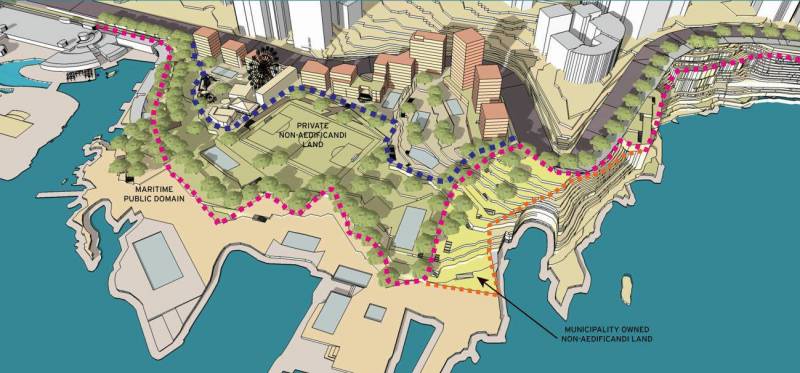
Returning the coast and the sea to the people of Beirut. This is the project that Beirut Madinati and the Issam Fares Institute of the American University of Beirut (AUB) have taken up.
Together, they have devised an urban development plan to facilitate access to Beirut’s 12 kilometer coastline. Launched in 2018, "this plan is a plea for the reaffirmation of Beirut’s coast as a shared non-developed space, open to all," says Mona Fawaz, Professor of Urban Planning at AUB, who has set up the project framework.
"Our wish is for the shoreline to be part of the city's landscape again," Fawaz added. "If the Lebanese capital continues on the path of privatization of the shoreline and construction there, then Beirut will no longer be a seaside city," she warned.
To restore Beirut’s shoreline, urban planners and architects involved in the project first looked at the zoning of Beirut’s waterfront, drawing on the current legal framework, notably the Beirut “Master Plan” (1954) and the urban planning code (1962).
This legal framework prohibits all permanent construction along the Corniche, including on private property. However, this restriction has been undermined by several decrees, in particular the law number 402 of 1995, specific to the seaside hotels sector, as it grants the owners of plots of 20,000 m2 the right to double the percentage of development of their plots thanks to an exceptional decree issued by the Council of Ministers and following the approval of the General Delegation of Urban Planning (DGU).
"Even if we just apply the existing laws, adjustments are possible and they can be far reaching," says Fawaz.
The master plan prepared by AUB and Beirut Madinati focuses on three specific areas.
First, the region of Aïn el-Mreissé, where the municipality is considering the construction of a large boardwalk that descends into the sea. "In the early 1900s, this area was known for its seaside activities. Aïn el-Mreissé status as a public area was further confirmed in the 1960s when the district became the city's recreation zone, explains Fawaz. “It is necessary to maintain this feature, " she adds. Fawaz’s team prefers to promote the installation of modern street benches, the construction of children’s playgrounds and swimming pools, as well as the rehabilitation of the Nejmeh football club’s field and the Luna Park amusement park.
In Dalieh, a place famed for family get togethers and the existence of a small fishing port located between the Mövenpick and the Pigeon Grotto, urban planners are more focused on the protection of the area’s heritage. "This is the region where the Pigeon Grotto is located, it is considered a national emblem of Lebanon and an environmental landmark," explains Fawaz. “Any construction would cause a considerable cultural, social, environmental and economic loss.”
The project, led by Beirut Madinati and the Urban Lab at AUB, therefore plans to demolish all illegal constructions "based on Article 19 of the urban planning code, which allows the expropriation of properties when it is necessary to build public gardens, which is applicable in this case," says Fawaz.
All the built upon plots would therefore be expropriated and the owners – in this case, mainly the heirs of Rafik Hariri – will be compensated with other lands of an equivalent value based on an exchange system, so that neither the owner nor the municipality find themselves at loss. Finally, there is the matter of the development of Ramlet el-Baida, "Beirut’s last public beach".
Architects and urban planners were inspired by the "French, Spanish and even Lebanese seaside resorts towns like Tyre," says Fawaz. According to her, the application of the legal framework would make it imperative to “demolish the Lancaster hotel, inaugurated in 2018 in Ramlet el-Baïda, and the expropriation of private lots along the beach".
The area would be further expanded by including the spaces previously reserved along the road for use as car parking spaces which would become underground parking lots under the new plan. On this new stretch, shops and restaurants could then be set up to create a real promenade by the sea.
Of course, many obstacles continue to hinder this development scheme. First, the appetite of real estate developers, whose links with the state and the government often allow them to circumvent urban planning regulations. However, Fawaz wants to believe that there is currently a window of opportunity.
"Too many scandals have tarnished the image of politicians and policy makers. They now need to redeem themselves. Returning the sea to people of Beirut could be the way," she said.
For this reason, the team at the Issam Farès Institute is working on revising current urban planning regulations to allow a more sustainable distribution between the public and private domains, and to ensure that what is public - or what has been historically for public use, such as private land near the coast – remain as such.
"We want to introduce a law that would facilitate the work of the Directorate General of Urban Planning (DGU) and the Municipality of Beirut, one that could be used as a model for other regions," said Fawaz.
This work is almost finished and should be presented to the public as well as to city councilors before the end of the summer.
This article was originally published in French.







